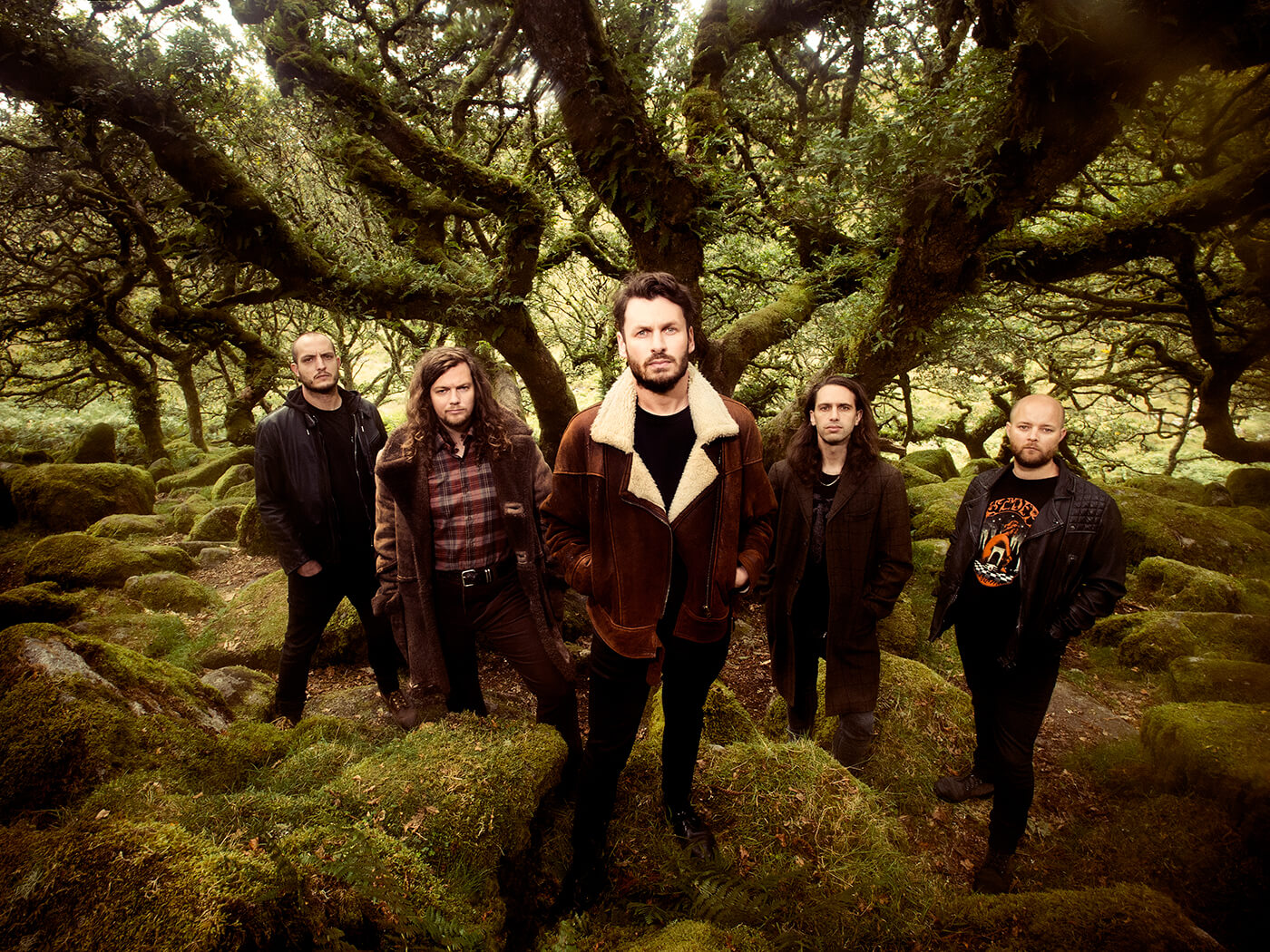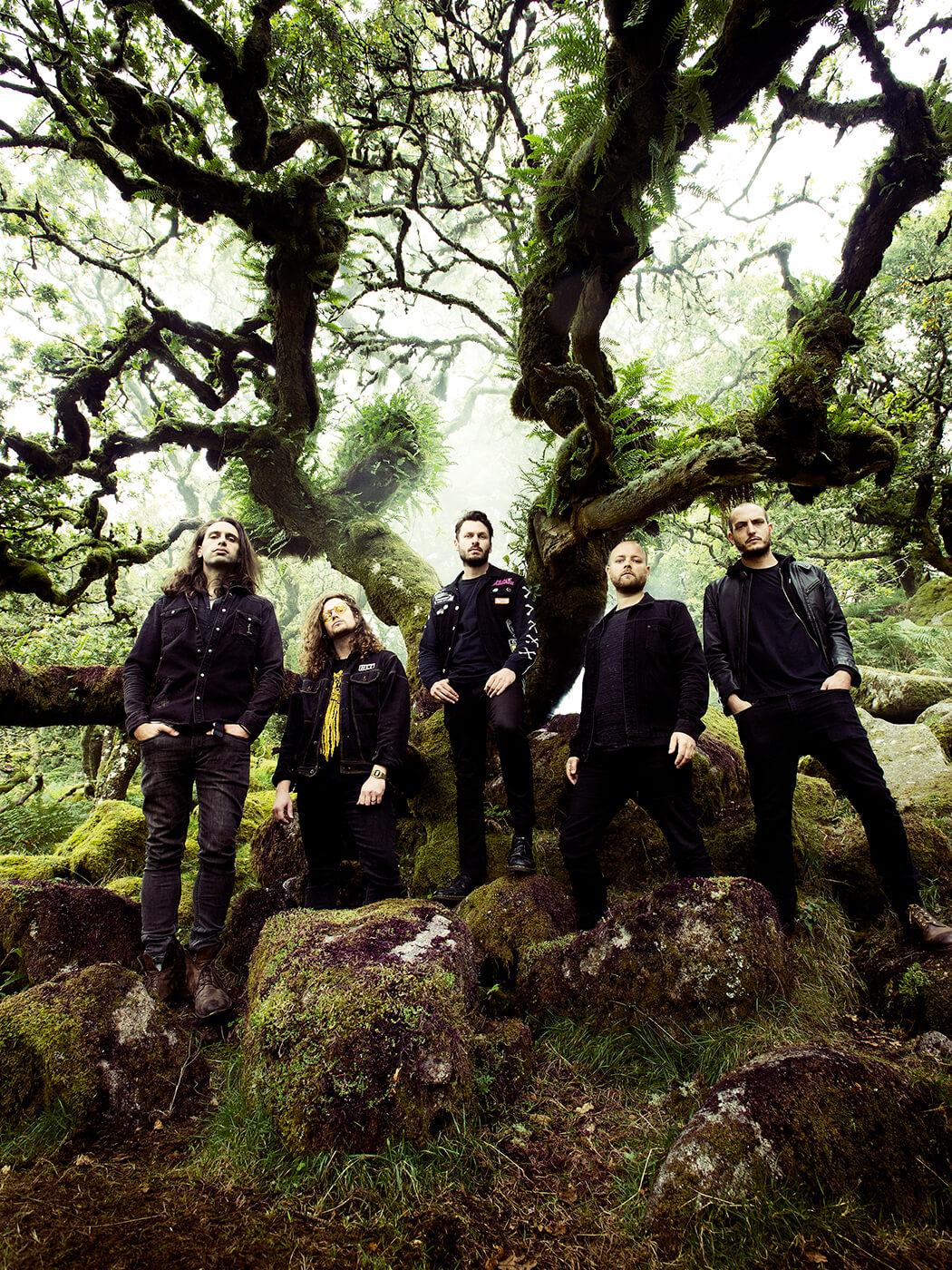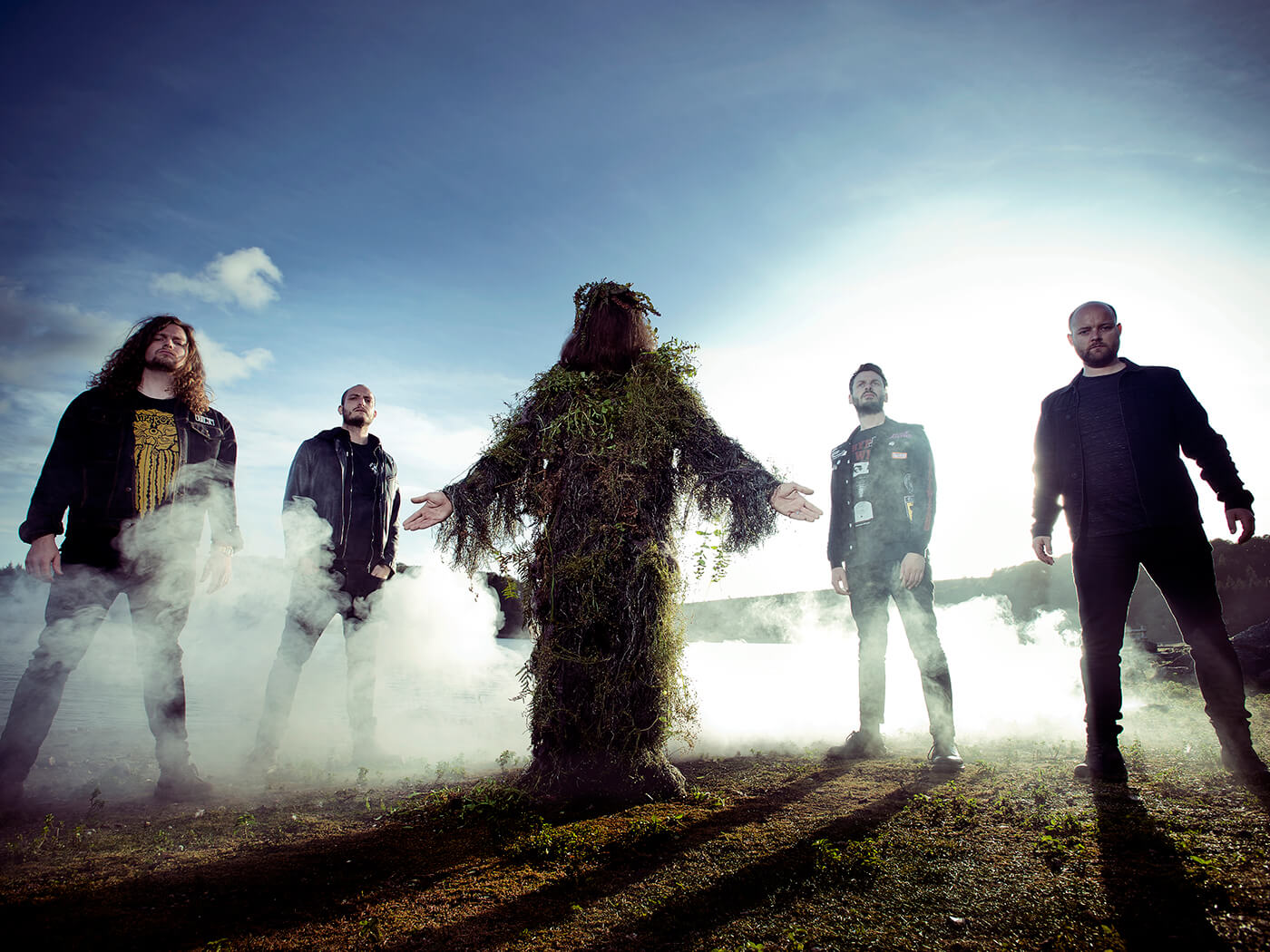Green Lung combat doom metal tropes in their latest release, Woodland Rites
The doom metal band from London discuss influences from Black Sabbath and Queen, and the album’s occult-related themes.

All images: Ester Segarra
Navigating the world of underground stoner doom is a bit like navigating a minefield – but instead of explosives, the landmines are packed to the brim with tropes and clichés. On the whole, the running is smooth – there’s plenty of creative takes on the genre, but with each step there’s the risk of an explosion of generic occultism, retro horror movie samples and overly long band names with the word ‘bong’ worked into them somehow. And from then on, you’ll be in an eternal internet argument about which bands sound too much (or not enough) like Black Sabbath, and why that’s a good (or bad) thing. A band sidestepping this minefield entirely, and by extension this slightly tortured metaphor, is Green Lung.
Guitarist Scott Black has in particular gone to lengths to ensure Green Lung don’t just feel like ‘another stoner band.’ As the first track of Woodland Rites, Initiation, gets going, you’re introduced to a forest soundscape – and you brace yourself for a sludgy tirade of blues-scale centric riffs. But something strange happens. The acoustic guitars build, and then – a soaring, harmonised lead part comes in. This is doom that takes a healthy amount of leaves out of ye olde book of proto-metal, but alongside this, there’s a distinctly bombastic flair running throughout the record.
Woodland Rites, initially released last year, is seeing a bigger and bolder reissue this spring via Svart Records. We sat down for a chat with Scott about taking the step to a bigger label, as well as the choice to avoid too many fuzz pedals and focusing on writing more hooks instead of trying too hard to emulate Black Sabbath.
Speaking of older proto-metal – in the world of underground doom, there’s a bit of a joke that every band worships Black Sabbath, perhaps to a fault. Do you feel pressure to distance yourself from that approach, one of constantly looking backwards?
When I was younger, I would have absolutely felt that way. I’ve never really been in many doom or stoner bands, I’d always been in hardcore and crossover thrash bands. So Green Lung was my first Doom band. I’d always known about Sleep, and those kinds of bands, and all the proto-metal bands, and always really liked them – but because I wasn’t that involved in the scene, there wasn’t that self-consciousness there. Which I think does accompany a lot of players that you see pushing it into much more inaccessible places, making songs really long and using much more extreme tones and vocals. I think that’s evolved from that Black Sabbath sound, but I don’t think we have that. We were more worried about writing songs that were catchy and fun, than worrying about whether it sounded like Black Sabbath.
You listen to Jerusalem/Dopesmoker by Sleep and it’s this whole transcendental hour-long album, and then you listen to Bad Brains and in two and a half minutes it’s delivered that same kind of punch you’d get over that whole hour. So my average commute soundtrack is going to be a lot more bite-sized, well-structured songs, and that’s something I think we deliberately wanted to do in Green Lung – just make things a bit more focused.
On that note, can I ask you about Brian May – that’s a comparison that’s made about your playing, more so than anyone else. Especially when you listen to Initiation, it’s quite a shock when instead of heavy riffs, a soaring, melodic harmonised solo comes in. What was it like trying to fit Brian May’s playing into a Tony Iommi-shaped hole?
I’m so glad you said that. When we started, it was like a theme band – I very much wanted to do ‘what if Black Sabbath had Brian May play guitar’, it was very deliberate. At first it’s quite intimidating to pull off that sort of playing, it was a gradual introduction. At the time Woodland Rites came about we wanted to make it very bombastic, and have those Queen influences on display.
With Initiation – I wanted to not waste anyone’s time. So if someone hated that, it was a song which went “this is what you’re going to deal with for the next half-hour. Get out when you still can.” The harmonies in that solo are constructed in a very Brian May-way – something you don’t hear anymore, because with digital recording, you can have unlimited tracks. Whereas with Brian, back in the 70s, that was a very expensive thing to do, have lots of tracks on the tape – so he would always pull out different harmonies. Like in Initiation, where it first begins with the first and the thirds, then moves to the thirds and the fifths, rather than having a three-part harmony. It lets your brain fill in the blanks, and it’s such a Brian May thing to do.
What’s really frustrating is, just after we released it, we started looking at comments online, like you always do. and everyone was saying it sounded like Dethklok, from Metalocalypse – that TV show. And I always thought that sounded like Scandanavian Melodic Death metal but they were talking about one specific song called Go Into the Water. But I couldn’t hear it all, but it has this middle-eight that’s so Brian May, very similarly to Initiation, basically in the same way that Initiation is ripping off Brian May. I found it so weird, these hundreds of kids saying that we’d ripped of Metalocalypse, when they didn’t realise who Metalocaplypse were ripping off. I did reply – linking them to the first Queen album. I got so frustrated I doxxed myself on Reddit…
What gear did you use on the record?
For woodland rites, it was a Greco Les Paul on one side, and an SG on the other. The Les Paul is one of those Japanese Lawsuit copies which I really like. For amps, we used a VOX AC-30 on one side – which is a very unusual doom amp. And we used a Laney Clip on the other, which is a bit more doom-y – it’s basically an early 70s Laney Supergroup with a treble booster built into it. We put those on either side for the rhythm tracks, and then we used a treble booster as well. Having played in a lot more thrash and tech-y metal, I’d want a much cleaner, more articulate guitar sound, rather than that wooly, orange-with-a-fuzz-pedal sound.
I used to play with them when we first started Green Lung because I thought that’s what you did. And I didn’t know what I was doing, so I basically thought “that guy uses a Big Muff, I guess I’ll use a Big Muff as well,” but I never really got on with it. There’s not enough clarity there. I feel like it’s hard to be an expressive guitar player with a fuzz pedal, and live – it just never cut through the mix. I tried tube screamers, that kind of thing – but they sounded a bit too angular, too modern still. So when I found out about treble boosters, they quickly became my favourite kind of overdrive.
https://www.youtube.com/watch?v=2lBYRgZOdAU
Because of their name, a lot of people think that they just boost treble – when someone first suggested I use one I said “why, what is that?” I had no idea it was this very primitive, dirty boost. The particular treble booster on Woodland Rites was a Naga Viper, it’s done by Catalinbread and it’s a Dallas Rangemaster clone.
That was for the rhythm tracks – all the lead tones were done with a dimed JCM800 and a Marshall Governor pedal in front of it. And we used a cocked wah as well, just to remove the bottom end a little more.
Do you think that clarity you got on this record shows the value in vintage gear many guitarists seek?
I do think there is a huge kind of vintage-fetishism with everyone. You see it so much in the Klon Centaurs, and all those clones – everyone’s obsessed with them. I played a real centaur once, and thought it was very nice. And then got on with my life.
Interestingly, I’ve done another very un-doom thing. I now use a Kemper live. I’ve got a tube amp tattoo, and I use a Kemper. That came because the two amps I use are very unreliable, known to explode all the time. I used to use two half-stacks live, which is a nightmare to transport and set up anyway. And they’d both blown up on one of the tours we were on, and I remember one of the venues had a Marshall MG solid state modelling combo , and I was thinking “Oh, my god, it’s going to sound horrible, this’ll be awful.” And no one noticed.
Looking into buying all this vintage gear, and it’s hugely expensive and unreliable. I have a friend called Bobby who plays in a punk band, who’d been telling me about Kempers for years – but I’d never believed him. It sounded too good to be true until I used it live, as I could actually use the sound that we recorded on the album.
Did you profile the exact amps that you recorded with?
We tried – I don’t think I did a very good job of profiling them so I just used other people’s Laney Clip profiles and found something that works well.
Once again, I think it comes back to that articulation. A lot of people don’t like them because when you’re playing them, it doesn’t feel like a tube amp when you’ve got this huge cab behind you and your legs are shaking with the volume of it. A Kemper does feel more like a guitar on a record, but once I got past that it just suits my playing more.
Do purists ever get annoyed that you use a modeling amp?
I get so much shit from that, I’ve taken to put the Kemper behind the cab. It’s one of those things about genre – everyone in djent uses them uses them, and no one cares, but as soon as you do it in something a bit more traditional everyone gets a bit upset with me.
What was your first guitar?
A Yamaha Pacifica was my first ever. I was obsessed with Angus Young, though, so I remember saving up all my money from my first job and buying an Epiphone SG. And it was horrible. it was so badly set up, and most of the notes above the 12th fret were dead.
My first amp was this weird Carlsbro that belonged to a friend of my mum’s – it was quite vintage, probably worth quite a lot of money. But when you’re 12 you don’t tend to notice…

Speaking of production – what was making the change from a far rawer sound on your Demo, to more high-fidelity production on the EP and Woodland Rites like?
A lot of the production stuff wasn’t that deliberate – when we recorded that demo, we had been together for two or three weeks, and we had an opportunity to do some recording somewhere – so we just went for it.
But I had no idea what I was doing. I was stacking two fuzz pedals into two amps, so the roughness was very much more us than the engineer and producer. I think we were reflective enough to know we didn’t really know what we were doing – so we wanted someone to have a bit more say in terms of sculpting our sound. So we went with a guy called Wayne Adams, who works out of Bear Bites Horse in London. He does mostly weird outsider noise-punk, much weirder bands than us. He was very important for the band in terms of not only recording, but what we wanted to do in terms of songwriting and aesthetics.
A lot of the production on Woodland Rites was a rejection of the kind of sound you get from a modern stoner doom band. In the mid-2000s, you had all of these post-hardcore band and they all sounded the same, it was all very scooped guitars – and I feel like this genre’s maybe heading in that direction. Not towards that specific sound, but where everything becomes homogeneous.
We wanted something almost less powerful, less bassy and monolithic – much more like a real band playing. So we use a lot less gain with the amps, and for the bass we used this old solid-state HH head, which is mostly associated with the bassist of the Smiths, who used it for ages. So we just stuck a Boss Blues Driver in front of that to get that clangy, percussive sound.

Who are you listening to right now?
There’re so many good bands right now. The first one that pops to mind is Elephant Tree, who have this incredible knack for writing super catchy hooks and vocal melodies – they’re almost more Shoegaze – think doomy shoegaze mixed with The Beatles. They’ve been very influential within London and the UK. Then there’s band’s like Juniper Grave, who we’re taking on tour with us in May, and they’re not particularly heavy, Blood Ceremony with more poppy songs. Theirs was one of my favourite albums last year. There’s bands like Magic Moss doing that kind of Deep Purple Proto Metal kind of thing which I really like. There’s bands like Tuskar, who call themselves ‘atomic sludge’ which sounds hilarious – but it’s a very apt description of what they sound like, and one of the best drummers I’ve ever seen in my life. Tyler sings and plays drums and just absolutely obliterates stuff.
Catch Green Lung at Desertfest, Hammerfest, Bloodstock 2020, or on their UK and Europe tour in May. Woodland Rites will be reissued by Svart this spring. Check out Green Lung on Facebook and Instagram, or on their website for more information.
